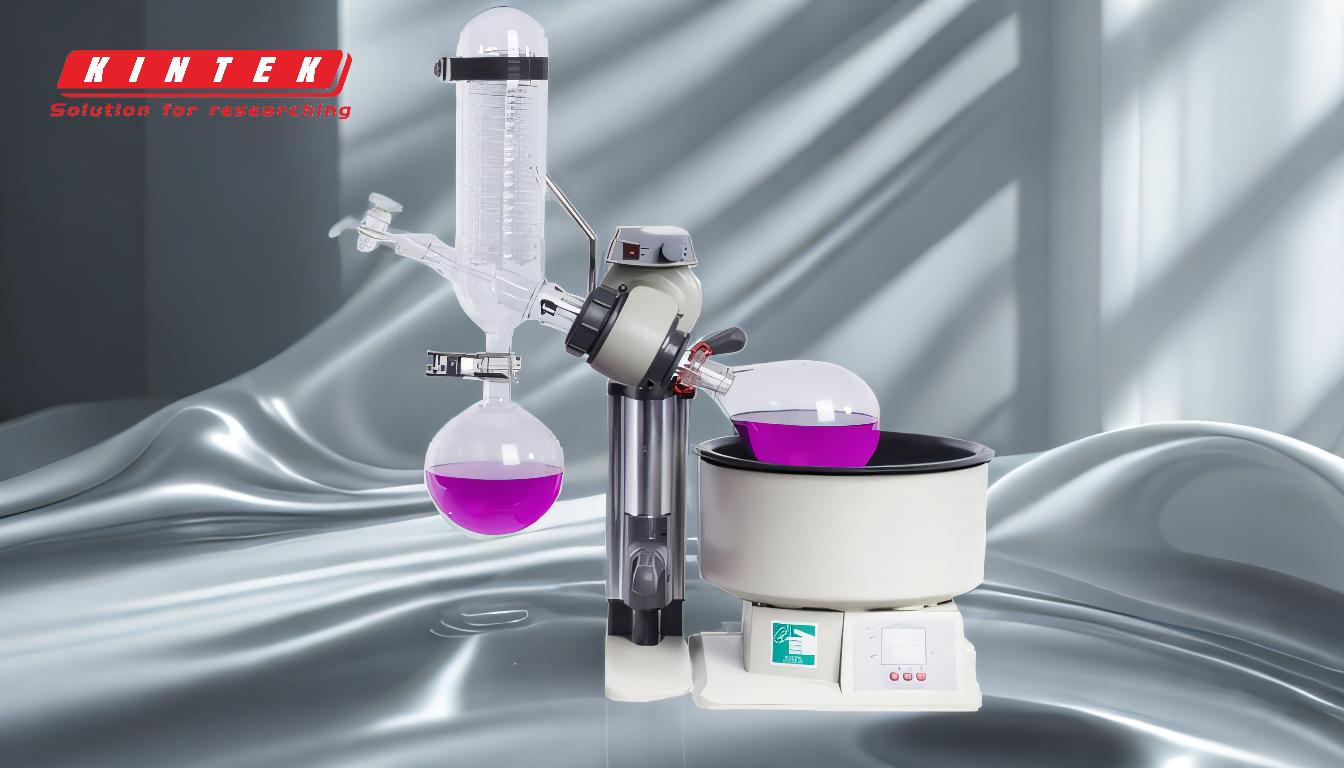A rotary evaporator, or rotovap, is a laboratory device designed to efficiently remove solvents from samples through evaporation under reduced pressure. It consists of several key components: a rotary motor that rotates the evaporation flask to increase surface area, a vacuum source to lower pressure and reduce boiling points, a heating bath to regulate temperature, a condenser to cool and recondense vaporized solvents, and a receiving flask to collect the distilled solvent. This process allows for gentle and controlled solvent removal, leaving behind a concentrated sample. Rotary evaporators are widely used in chemistry, pharmaceuticals, and research for solvent recovery and sample concentration.
Key Points Explained:

-
Rotary Motor:
- Function: Rotates the evaporation flask to increase the surface area of the liquid, promoting even mixing and faster evaporation.
- Importance: The rotation ensures that the solvent forms a thin film on the flask's interior, which accelerates evaporation and prevents overheating of the sample.
-
Vacuum Source:
- Function: Creates a vacuum within the system to reduce pressure, thereby lowering the boiling point of the solvent.
- Importance: Lowering the boiling point allows for evaporation at lower temperatures, which is crucial for heat-sensitive compounds and prevents degradation.
-
Glass Tube:
- Function: Protects the sample and aids in maintaining the vacuum within the system.
- Importance: The glass tube ensures that the sample remains uncontaminated and that the vacuum is effectively maintained for efficient evaporation.
-
Heating Bath:
- Function: Heats the sample and regulates the temperature to facilitate controlled evaporation.
- Importance: Precise temperature control is essential to prevent overheating and to ensure that the solvent evaporates at an optimal rate.
-
Condenser:
- Function: Cools the evaporated solvent vapor, causing it to condense back into a liquid.
- Importance: The condenser is critical for recovering the solvent in its liquid form, which can then be collected and reused or analyzed.
-
Receiving Flask:
- Function: Collects the condensed solvent after it passes through the condenser.
- Importance: The receiving flask allows for the separation and collection of the solvent, leaving the concentrated sample in the original flask.
-
Evaporation Flask:
- Function: Holds the sample and solvent mixture that is being evaporated.
- Importance: The flask's design and rotation ensure efficient evaporation and concentration of the sample.
-
Water Bath:
- Function: Provides a controlled heat source to the evaporation flask.
- Importance: The water bath ensures uniform heating, which is crucial for consistent evaporation rates and sample integrity.
-
Condenser Cooling System:
- Function: Maintains a low temperature in the condenser to ensure efficient condensation of solvent vapors.
- Importance: Effective cooling is necessary to maximize solvent recovery and prevent loss of volatile compounds.
-
Vacuum Pump:
- Function: Reduces the pressure within the system to facilitate evaporation at lower temperatures.
- Importance: The vacuum pump is essential for creating the reduced pressure environment that makes rotary evaporation possible.
By understanding these components and their functions, users can effectively operate a rotary evaporator to achieve optimal solvent removal and sample concentration. This knowledge is particularly valuable for purchasers, as it helps in selecting the right equipment based on specific laboratory needs and applications.
Summary Table:
| Component | Function | Importance |
|---|---|---|
| Rotary Motor | Rotates the evaporation flask to increase surface area for faster evaporation | Ensures even mixing, prevents overheating, and accelerates solvent removal |
| Vacuum Source | Reduces pressure to lower the solvent's boiling point | Enables evaporation at lower temperatures, protecting heat-sensitive compounds |
| Glass Tube | Protects the sample and maintains vacuum integrity | Prevents contamination and ensures efficient evaporation |
| Heating Bath | Regulates temperature for controlled evaporation | Prevents overheating and ensures optimal evaporation rates |
| Condenser | Cools and recondenses vaporized solvents | Recovers solvents in liquid form for reuse or analysis |
| Receiving Flask | Collects the condensed solvent | Separates and collects solvents, leaving concentrated samples |
| Evaporation Flask | Holds the sample and solvent mixture for evaporation | Ensures efficient evaporation and concentration of the sample |
| Water Bath | Provides uniform heating to the evaporation flask | Maintains consistent evaporation rates and sample integrity |
| Condenser Cooling System | Maintains low condenser temperatures for efficient condensation | Maximizes solvent recovery and prevents loss of volatile compounds |
| Vacuum Pump | Reduces system pressure to enable evaporation at lower temperatures | Essential for creating the reduced pressure environment |
Ready to optimize your lab's solvent recovery process? Contact us today to find the perfect rotary evaporator for your needs!











